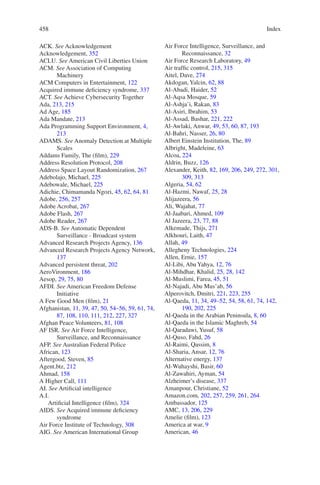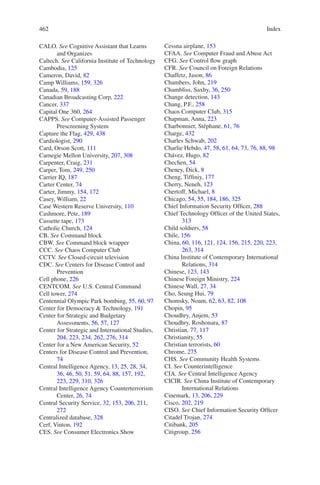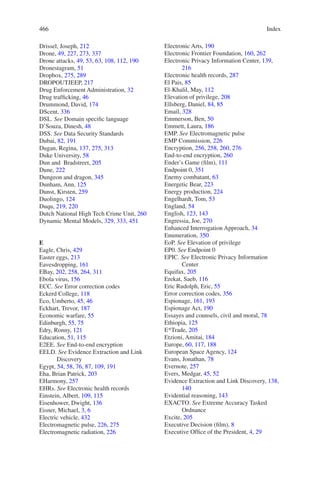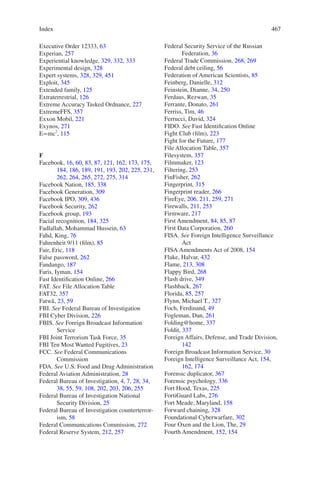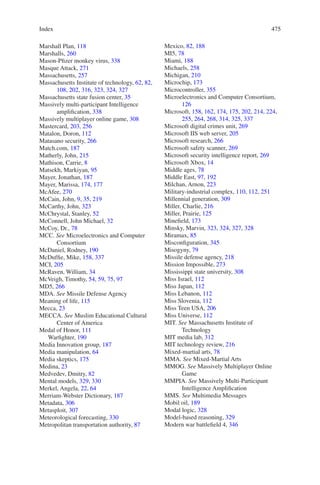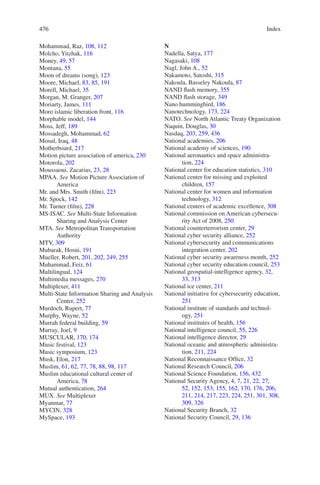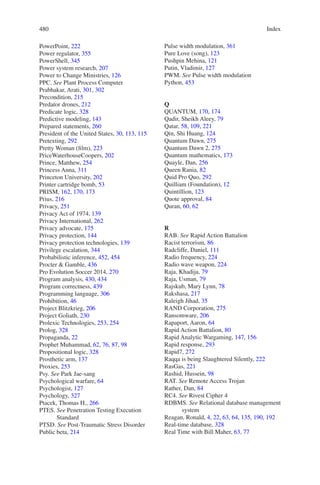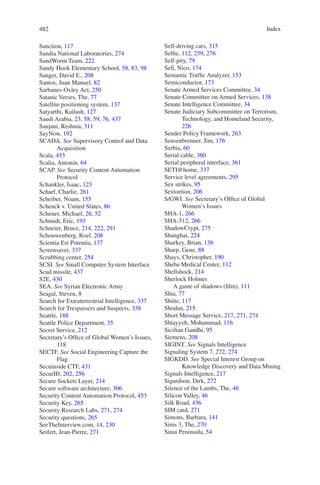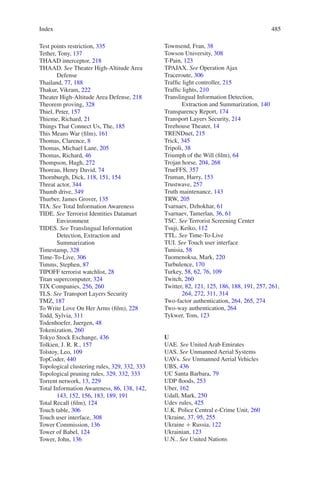The document provides a comprehensive overview of counterterrorism, including historical events like the September 11 attacks, the responses from various entities, and the evolution of the U.S. intelligence community. It discusses strategies for understanding and curing terrorism, the implications of cybersecurity, and the role of technologies such as Total Information Awareness. The document highlights both operational failures and lessons learned, emphasizing collaboration and informed approaches to counterterrorism efforts.
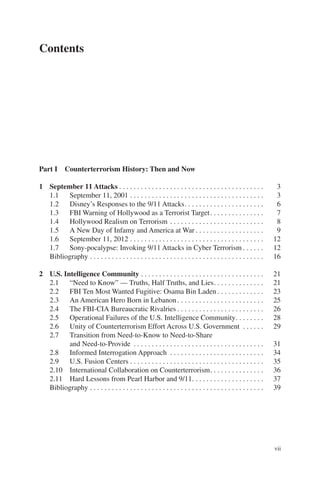


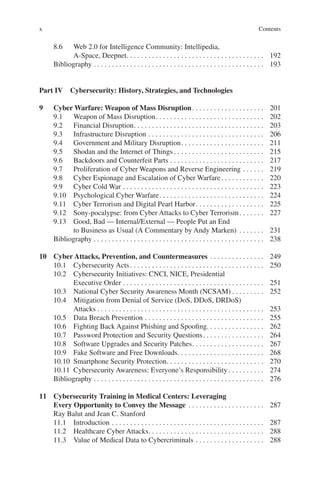




![4 1 September 11 Attacks
Christopher Nolan, writer-director of Inception (2010), once said that “ever
since he was a youngster, he was intrigued by the way he would wake up and then,
while he fell back into a lighter sleep, hold on to the awareness that he was in fact
dreaming. Then there was the even more fascinating feeling that he could study
the place and tilt the events of the dream” [1].
Similarly, whenever I was having a nightmare, I would either semiconsciously
alter the chain of events to achieve a less sinister outcome, or I would force myself
to wake up and escape to reality or to a new dream state about waking up.
However, as I awoke to the radio news broadcast on the morning of September
11, I realized that it was not a lucid dream. New York City and the Pentagon were
under attack. The U.S. airspace was shut down. The alternative universe was the
present reality.
I went to work that morning in a state of shock and disbelief. As I entered the
lobby of Disney Online, I saw a television on a portable TV cart adjacent to the
reception desk. Several people were standing in front of the television. No one
spoke a word. We watched the replays of an airplane crashing into the South
Tower of the World Trade Center, people jumping out of the broken windows, and
the collapse of the North and South Towers. It was surreal and somber.
The Disney Online office was uncharacteristically quiet that morning. I tried
my best to focus on work, but my mind kept wandering off to the unfolding disas-
ters in the East Coast and my reminiscence of the year 1984 in Virginia.
In the summer of 1984, Virginia Tech professor Dr. Timothy Lindquist intro-
duced me to Dr. John F. Kramer at the Institute for Defense Analyses (IDA), a
nonprofit think tank serving the U.S. Department of Defense (DoD) and the
Executive Office of the President [2]. A year prior, I received a surprise letter
from the White House signed by President Ronald Reagan, thanking me for my
support. Partially motivated by the letter, I accepted the internship offer at IDA
and became a research staff member. My summer project was to assist DoD in
drafting the Military Standard Common APSE (Ada Programming Support
Environment) Interface Set (CAIS) [3].
My winter project was to design a counterterrorism software program for a
multi-agency joint research effort involving the Defense Advanced Research
Projects Agency (DARPA), National Security Agency (NSA), and Federal Bureau
of Investigation (FBI). The FBI was investigating the deadly terrorist attacks
against the U.S. embassy and military barrack in Beirut, Lebanon. As a co-pioneer
of artificial intelligence applications in counterterrorism, I helped develop a natu-
ral language parser and machine learning program to digest news and articles in
search of potential terrorist threats around the globe.
I left IDA for Bell Laboratories in 1985. However, the IDA counterterrorism
project came across my mind in December 1988 when the New York-bound Pan
Am Flight 103 exploded from a terrorist bomb over Lockerbie, Scotland, killing
all 259 aboard and 11 on the ground [4]. The passengers included 35 Syracuse
University students returning home for a Christmas break. Their surviving families
were devastated by the Lockerbie bombing.](https://image.slidesharecdn.com/4e941a39-7c10-40b2-bfdf-f00669949e38-150422133920-conversion-gate01/85/Counterterrorism-and-Cybersecurity-Total-Information-Awareness-9-320.jpg)
![21
Secrecy stifles oversight, accountability, and information sharing.
— The 9/11 Commission (July 22, 2004)
The situation was, and remains, too risky to allow someone
to experiment with amateurish, Hollywood style interrogation
methods - that in reality - taints sources, risks outcomes,
ignores the end game, and diminishes our moral high ground
in a battle that is impossible to win without first capturing the
hearts and minds around the world. It was one of the worst and
most harmful decisions made in our efforts against al-Qaeda.
— Former FBI Agent Ali Soufan (May 13, 2009)
In solving intelligence problems, including diversity of thought
is essential.
— Letitia “Tish” Long, Director of the National Geospatial-
Intelligence Agency (2012)
You know enough to know what’s not true, but you can’t
necessarily connect all of the dots to know what is true. ... The most
effective propaganda is a mixture of truths, half truths, and lies.
— American author Richard Thieme at DEF CON 22
(August 8, 2014)
2.1 “Need to Know” — Truths, Half Truths, and Lies
“You can’t handle the truth!” exclaimed Col. Nathan R. Jessup played by Jack
Nicholson in the 1992 legal drama A Few Good Men. “Son, we live in a world
that has walls, and those walls have to be guarded by men with guns. … You don’t
want the truth, because deep down in places you don’t talk about at parties, you
want me on that wall. You need me on that wall” [1].
On August 8, 2014 at DEF CON 22 in Las Vegas, American author Richard Thieme
recalled a conversation with his friend from the National Security Agency (NSA) who
Chapter 2
U.S. Intelligence Community
© Springer International Publishing Switzerland 2015
N. Lee, Counterterrorism and Cybersecurity, DOI 10.1007/978-3-319-17244-6_2](https://image.slidesharecdn.com/4e941a39-7c10-40b2-bfdf-f00669949e38-150422133920-conversion-gate01/85/Counterterrorism-and-Cybersecurity-Total-Information-Awareness-10-320.jpg)
![22 2 U.S. Intelligence Community
spoke of the difficulty in knowing the truth: “You know enough to know what’s not
true, but you can’t necessarily connect all of the dots to know what is true” [2].
A commentator on technology and culture, Thieme gave his talk at DEF CON
for the 19th years and is widely considered to be a “father figure” in hacker con-
ventions worldwide. He told a story about U.S. Army General Alexander Haig
who served as the U.S. Secretary of State under President Ronald Reagan from
1981 to 1982: “In a small Italian newspaper where a piece of really great investi-
gative reporting revealed that the KGB during the Cold War was sponsoring terror-
ism all over the world and supporting groups that were antithetical to the United
States and its intentions. That small story caught the attention of an author and
journalist who wrote a piece about it for The New York Times and also wrote a
book about it. That came to the attention of Alexander Haig who was Secretary of
State; and he became very, very alarmed and he held a press conference in which
he demanded that the CIA explore this revelation in order to counter the nefari-
ous and insidious work of the KGB in this way. William Casey, director of CIA,
said ‘we’ll get right on it.’ Six months later the result came back: ‘We’ve explored
that, you don’t have to worry about that particular thing.’ Why? Because the story
in the Italian newspaper was a CIA plant in the first place. In other words, it was
just propaganda to smear the Soviets, but it was picked up by our own journalist
who didn’t know any better and couldn’t, turned into a book which went to the
Secretary of State and then became an alarming consideration, and the CIA could
not tell him the truth” [2].
The U.S. Secretary of State is the head of the State Department responsible
for overall direction, coordination, and supervision of activities of the U.S.
government overseas. Yet CIA director William Casey had kept U.S. Army
General Alexander Haig in the dark for most of his career as Secretary of State.
The “need to know” syndrome had reached epidemic proportions within the U.S.
government, all the way to the top including Presidents of the United States (i.e.
giving the Presidents the benefit of the doubt).
In March 1987 during the Iran-Contra affair, President Ronald Reagan said in
a televised press conference that “he was not aware of a two-year secret campaign
organized by key White House aides, including two advisers he saw nearly every day,
to ship millions of dollars in arms to Nicaraguan contra rebels” and that “he was not
aware of the alleged diversion of funds from U.S. arms sales to Iran to the rebels” [3].
In October 2013 amid Edward Snowden’s NSA leaks, President Barack Obama
was reportedly unaware of the United States spying on its ally leaders: “The
National Security Agency ended a program used to spy on German Chancellor
Angela Merkel and a number of other world leaders after an internal Obama admin-
istration review started this summer revealed to the White House the existence of
the operation, U.S. officials said … The account suggests President Barack Obama
went nearly five years without knowing his own spies were bugging the phones of
world leaders. Officials said the NSA has so many eavesdropping operations under
way that it wouldn’t have been practical to brief him on all of them” [4].
“The most effective propaganda,” Thieme said, “is a mixture of truths, half
truths, and lies” [2].](https://image.slidesharecdn.com/4e941a39-7c10-40b2-bfdf-f00669949e38-150422133920-conversion-gate01/85/Counterterrorism-and-Cybersecurity-Total-Information-Awareness-11-320.jpg)
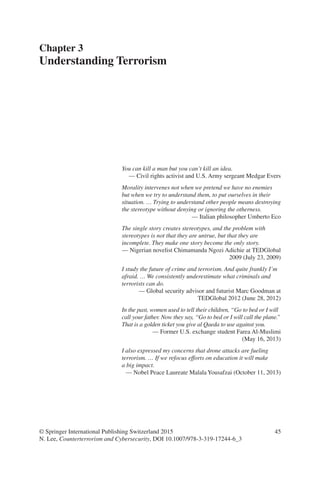
![46 3 Understanding Terrorism
[The Americans] is a show that asks us to give a human face
to people we might consider our enemies, to understand the
underlying humanity, complexity, and conflicts of people on
both sides of any particular divide.
— Richard Thomas who plays FBI agent Frank Gaad in
The Americans (TV Series, 2014)
3.1 “Give a Human Face to People We Consider
Our Enemies” — The Americans
Academy Award-winning actress Angelina Jolie was in Japan on 9/11, and she
recalled, “It was this other strange thing for me, because it was obviously a country
where if you would have turned the clock back, it was an enemy. And now, on that date,
for me as an American, they were my allies, my friends, taking care of me, giving me
sympathy for my country. I became immediately conscious of how things shift, how the
picture of the enemy shifts. I don’t have any answers, but to be aware of all these things
as it’s coming down — it’s not as simple as, ‘Well, this is the bad guy’” [1].
Italian philosopher Umberto Eco once said, “I would argue that morality inter-
venes not when we pretend we have no enemies but when we try to understand
them, to put ourselves in their situation. … Trying to understand other people
means destroying the stereotype without denying or ignoring the otherness” [2].
Created and produced by former CIA officer Joe Weisberg, The Americans is a
TV show that “asks us to give a human face to people we might consider our ene-
mies, to understand the underlying humanity, complexity, and conflicts of people
on both sides of any particular divide,” said Richard Thomas who plays FBI Agent
Frank Gaad in the show.
Drugs and terrorism are both mind-altering and deadly. Long before President
George W. Bush declared the global war on terror in 2001, President Richard
Nixon declared drug abuse “public enemy number one” in 1971. Today, the
United States spends about $51 billion annually on the war on drugs with no end
in sight [3]. The black market for illicit drugs follows the same fundamental con-
cepts of economics: supply and demand. One may recall the fiasco of the 1920-
1933 Prohibition in the United States that gave organized crime a major boost.
Similarly, there will always be drug trafficking for as long as there are affluent
customers paying high prices for illegal substances. “The billionaires I know,
almost without exception, use hallucinogens on a regular basis,” said Silicon
Valley investor Tim Ferriss. “[They’re] trying to be very disruptive and look at the
problems in the world … and ask completely new questions” [4].
Give a human face to drug users and understand why they need narcotics is the
only chance that we have to win the war on drugs [5].
After the 9/11 attacks in 2001, President Bush described the long, drawn-out
war on terror: “We’re a nation that is adjusting to a new type of war. This isn’t a](https://image.slidesharecdn.com/4e941a39-7c10-40b2-bfdf-f00669949e38-150422133920-conversion-gate01/85/Counterterrorism-and-Cybersecurity-Total-Information-Awareness-13-320.jpg)

![74 4 Cures for Terrorism
metastasizing and turning into a global network” [1]. In other words, terrorism is
metastasizing like cancer in the global body of humanity.
Dracunculiasis, also known as Guinea worm disease (GWD), is caused by the
parasite Dracunculus medinensis. The disease affects communities that do not have
safe water to drink. There is no vaccine or drug therapy for Guinea worm disease.
Through health education and innovative low-cost water treatments, the Carter
Center has led the effort to eradicate the disease in collaboration with the Centers
for Disease Control and Prevention (CDC), the World Health Organization (WHO),
the United Nations Children’s Fund (UNICEF), and the Bill Melinda Gates
Foundation. Two decades of eradication efforts have successfully reduced Guinea
worm disease infection cases from 3.5 million worldwide in 1986 to a miniscule
148 cases in 2013 [2]. The Carter Center has predicted that “Guinea worm disease
is poised to be the next human disease after smallpox to be eradicated” [3].
Henry “Hank” Crumpton, former deputy director of the Central Intelligence
Agency (CIA) Counterterrorism Center, led an insurgent to overthrow the Taliban
and to attack al-Qaeda in Afghanistan just after 9/11. Crumpton spoke at the
Aspen Security Forum in July 2012 about the war on terror: “It’s a different type
of war. Dealing with terror is going to be more like managing disease” [4].
There are two fundamental ways to manage disease: treat the symptoms or
remedy the root causes. Crumpton chose the former, the symptomatic treatment.
In his 2010 interview on 60 Minutes, Crumpton told CBS correspondent Lara
Logan, “[My] orders were fairly simple: Find al-Qaeda and kill them, especially
leadership. Destroy command and control. … If they kill me, I have told my fam-
ily and my friends not to complain about anything, because I have killed many of
them with pride” [5].
In spite of the operational successes, Crumpton admitted, “There will be an
attack in the homeland. And sadly I think we face that prospect in the future. I
think we’ll be hit again.” When Logan asked if such an attack would be on the
scale of 9/11, he responded, “It’s certainly possible. Or perhaps even greater” [5].
In his 2012 autobiography American Sniper, Navy SEAL marksman Chris Kyle
expressed his only regret that “he didn’t kill more” after having more than 160
confirmed kills during his four combat tours in Iraq [6]. In February 2015, CNN
Pentagon Correspondent Barbara Starr revealed that the U.S. government has a secret
‘hit list’ of ISIS suspects: “The United States has already killed a dozen or so ISIS
operatives on the list, including an ISIS chemical weapons expert, the senior official
says. But others are added to the list as intelligence is gained about their role in ISIS”
[7]. In other words, the list is getting longer as we know more about ISIS operations.
Trying to get rid of the symptoms (terrorists) without paying attention to the
root causes (terrorist motives) does not eradicate the disease but may instead
exacerbate it. American author and philosopher Henry David Thoreau wrote in
his book Walden; or, Life in the Woods that “there are a thousand hacking at the
branches of evil to one who is striking at the root” [8]. Jon Lovett, former speech-
writer to President Barack Obama, talked about important issues facing America
and he said, “The bottom line is, you don’t beat an idea by beating a person. You
beat an idea by beating an idea” [9].](https://image.slidesharecdn.com/4e941a39-7c10-40b2-bfdf-f00669949e38-150422133920-conversion-gate01/85/Counterterrorism-and-Cybersecurity-Total-Information-Awareness-15-320.jpg)
![107
World peace is as simple and elegant as E = mc2.
—Newton Lee
Peace cannot be kept by force. It can only be achieved by
understanding.
—Albert Einstein (December 14, 1930)
Too many of us think [peace] is impossible. Too many think
it unreal. But that is a dangerous, defeatist belief. … Our
problems are manmade—therefore they can be solved by man.
—President John F. Kennedy (June 10, 1963)
We must either love each other, or we must die.
—President Lyndon Johnson in “Peace Little Girl (Daisy)”
(September 7, 1964)
Violence never brings permanent peace. It solves no social
problem: it merely creates new and more complicated ones.
—Martin Luther King Jr.
Nobel Peace Prize acceptance speech (December 11, 1964)
The belief that peace is desirable is rarely enough to achieve it.
Peace requires responsibility. Peace entails sacrifice.
—President Barack Obama,
Nobel Peace Prize acceptance speech (December 10, 2009)
If there is an Internet connection, my camera is more powerful
[than my AK-47].
—Syrian dissident Abu Ghassan (June 2012)
Instead of building walls to create security, we need to build
bridges.
—U.S. Navy Admiral and former NATO’s Supreme Allied
Commander James Stavridis, TEDGlobal 2012 (June 2012)
Chapter 5
War and Peace
© Springer International Publishing Switzerland 2015
N. Lee, Counterterrorism and Cybersecurity, DOI 10.1007/978-3-319-17244-6_5](https://image.slidesharecdn.com/4e941a39-7c10-40b2-bfdf-f00669949e38-150422133920-conversion-gate01/85/Counterterrorism-and-Cybersecurity-Total-Information-Awareness-16-320.jpg)
![108 5 War and Peace
We believe that relationships between nations aren’t just about
relationships between governments or leaders—they’re about
relationships between people, particularly young people.
—First Lady Michelle Obama (March 25, 2014)
The meaning of our whole life and existence is love.
—Russian President Vladimir Putin (November 7, 2014)
5.1 War as State-Sponsored Terrorism
The Federal Bureau of Investigation (FBI) defines terrorism as “the unlawful use
of force or violence against persons or property to intimidate or coerce a govern-
ment, the civilian population, or any segment thereof in furtherance of political
or social objectives” [1]. MIT Professor Emeritus Noam Chomsky believes that
the U.S. official doctrine of low-intensity warfare is almost identical to the official
definition of terrorism [2]. Political commentator Bill Maher equates U.S. drone
attacks with terrorist acts [3].
While a terrorist act causes innocent people pain, suffering, and even death, war
is legitimized state-sponsored terrorism in a grand scale. In World War II, 15 mil-
lion soldiers died in battles while 45 million civilians perished under war-related
circumstances [4]. Between five and six million Jews were killed in the Holocaust
[5]. Over 27 % of the civilian population in Hiroshima and 24 % of the residents
in Nagasaki were wiped out by atomic bombs [6].
In war-torn countries, people live in constant fear. Jesuit priest and peace activist
John Dear interviewed families at the refugee camps in Afghanistan in December 2012.
Raz Mohammad, a member of Afghan Peace Volunteers, told his somber story [7]:
My brother-in-law was killed by a U.S. drone in 2008. He was a student, and visiting
some friends one summer evening when they decided to walk to a garden and sit there
and talk. They were enjoying the evening, sitting in the garden, when a drone flew by
and dropped a bomb. Everyone was incinerated. We couldn’t find any remains. My sis-
ter was left behind with her baby boy. I think the drone attacks were first begun in my
province. We hear them about every three nights. They have a low, buzzing sound, like a
mosquito. They hover over us. They fly over us during the day, and fly over us during the
night, when we can see the spotlight at the front of the drone. Occasionally, the large U.S.
fighter bombers fly over, and they make a huge noise. All the people of the area, espe-
cially the children, are afraid of the U.S. soldiers, the U.S. tanks, the U.S. drones, and the
U.S. fighter bombers. They fear being killed.
…
No one I know wants the war to continue. Ordinary people everywhere are sick and tired
of war, yet we’re demonized as warriors and terrorists. None of us can tell who is a mem-
ber of the Taliban and who isn’t. If we can’t tell who is a member of the Taliban, how can
anyone in the U.S. claim to know who is in the Taliban? Meanwhile, our schools, hospi-
tals and local services have all collapsed. The U.S./NATO forces are not helping anyone,
only bringing fear and death to the people.
At a women’s sewing cooperative in Afghanistan, a woman expressed her frustra-
tion and pleaded: “I thought President Obama would care for the oppressed, but he](https://image.slidesharecdn.com/4e941a39-7c10-40b2-bfdf-f00669949e38-150422133920-conversion-gate01/85/Counterterrorism-and-Cybersecurity-Total-Information-Awareness-17-320.jpg)
![135
Let us not look back in anger, nor forward in fear, but around in
awareness.
—American cartoonist and writer James Grover Thurber
Vital information for the millions outweighs the privacy of the few.
—Newton Lee
Scientia potentia est. (Knowledge is power.)
—Thomas Hobbes in De Homine (Man) (1658)
Information is the oxygen of the modern age.
—President Ronald Reagan (June 14, 1989)
It would be no good to solve the security problem and give up
the privacy and civil liberties that make our country great.
—Admiral John Poindexter (August 12, 2003)
6.1 President Ronald Reagan and Admiral John
Poindexter
American cartoonist and writer James Grover Thurber once said, “Let us not look
back in anger, nor forward in fear, but around in awareness.” President Ronald
Reagan had long recognized the vital importance of communications technology
and information sharing as he said in June 1989 after having served two terms as
the President of the United States [1]:
Information is the oxygen of the modern age…. It seeps through the walls topped with
barbed wire. It wafts across the electrified, booby-trapped borders. Breezes of electronic
beams blow through the Iron Curtain as if it was lace…. The Goliath of totalitarian con-
trol will rapidly be brought down by the David of the microchip.
Chapter 6
The Rise and Fall of Total Information
Awareness
© Springer International Publishing Switzerland 2015
N. Lee, Counterterrorism and Cybersecurity, DOI 10.1007/978-3-319-17244-6_6](https://image.slidesharecdn.com/4e941a39-7c10-40b2-bfdf-f00669949e38-150422133920-conversion-gate01/85/Counterterrorism-and-Cybersecurity-Total-Information-Awareness-18-320.jpg)
![136 6 The Rise and Fall of Total Information Awareness
Back in April 1984, President Reagan signed the National Security Decision
Directive (NSDD) 138: Combating Terrorism, which authorized the increase of
intelligence collection directed against groups or states involved in terrorism [2].
Reagan appointed Navy Vice Admiral John Poindexter as the National Security
Advisor in December 1985. With a Ph.D. in Nuclear Physics from California
Institute of Technology (Caltech), Poindexter had been a strong advocate of new
computer technology and distributed data management system during his tenure
in the U.S. military. In November 1986, however, Poindexter was forced to resign
from the White House Office and retire as Rear Admiral due to his role in the Iran-
Contra Affair [3].
After a 3-month investigation by the Tower Commission headed by for-
mer Senator John Tower, President Reagan addressed the nation in March 1987
acknowledging the danger of unchecked covert operations and the need for
stronger presidential oversight [4]:
A few months ago I told the American people I did not trade arms for hostages. My heart
and my best intentions still tell me that’s true, but the facts and the evidence tell me it is
not…. I’m taking action in three basic areas: personnel, national security policy, and the
process for making sure that the system works…. I have had issued a directive prohibiting
the NSC [National Security Council] staff itself from undertaking covert operations — no
ifs, ands, or buts.
In March 1988, Poindexter and Lieutenant Colonel Oliver North were indicted
on charges of conspiracy to defraud the United States by illegally providing the
Nicaraguan rebels with profits from the sale of American weapons to Iran [5].
In April 1990, Poindexter was convicted on five counts of lying to Congress and
obstructing the Congressional investigation of the Reagan Administration’s cov-
ert arms sales to Iran and the diversion of some proceeds to rebels fighting the
Marxist Government in Nicaragua. However, in November 1991, the District of
Columbia Circuit Court overturned Poindexter’s conviction by a vote of two to
one [6].
A day after September 11, 2001, Poindexter lamented with his close friend
Brian Sharkey that they had not prevented the terrorist attacks [7]. Sharkey was
a former program manager at the Defense Advanced Research Projects Agency
(DARPA). Poindexter was working for BMT Syntek Technologies, a defense
contractor that was developing Project Genoa, a data-mining decision-support
system for DARPA. Genoa provided analyst tools to augment human cognitive
processes and aid understanding of complex arguments [8]. After the 9/11 attacks,
Poindexter wanted to put Project Genoa on steroids.
6.2 Defense Advanced Research Projects Agency (DARPA)
Defense Advanced Research Projects Agency (DARPA) was created as Advanced
Research Projects Agency (ARPA) in 1958 by President Dwight Eisenhower in
response to the surprise Sputnik launch by the Soviet Union a year before [9].](https://image.slidesharecdn.com/4e941a39-7c10-40b2-bfdf-f00669949e38-150422133920-conversion-gate01/85/Counterterrorism-and-Cybersecurity-Total-Information-Awareness-19-320.jpg)
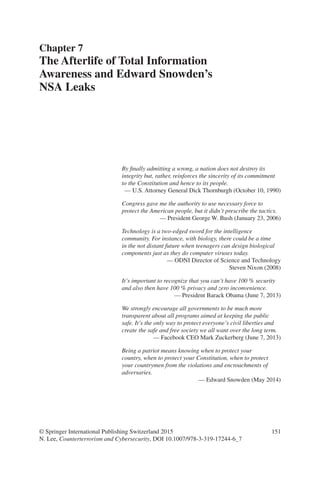
![152 7 The Afterlife of Total Information Awareness …
7.1 NSA’s Terrorist Surveillance Program
Although the U.S. Congress axed the Information Awareness Office (IAO) and dis-
mantled Total Information Awareness (TIA) in September 2003, TIA did not really
cease to exist. Five years later in March 2008, a Wall Street Journal article reported
that the National Security Agency (NSA) has been building essentially the same
system as TIA for its Terrorist Surveillance Program and other U.S. governmental
agencies. Wall Street Journal intelligence correspondent Siobhan Gorman wrote [1]:
According to current and former intelligence officials, the spy agency now monitors huge
volumes of records of domestic emails and Internet searches as well as bank transfers,
credit-card transactions, travel and telephone records. The NSA receives this so-called
“transactional” data from other agencies or private companies, and its sophisticated soft-
ware programs analyze the various transactions for suspicious patterns.
Two current officials also said the NSA’s current combination of programs now largely
mirrors the former TIA project. But the NSA offers less privacy protection. TIA develop-
ers researched ways to limit the use of the system for broad searches of individuals’ data,
such as requiring intelligence officers to get leads from other sources first. The NSA effort
lacks those controls…
The NSA uses its own high-powered version of social-network analysis to search
for possible new patterns and links to terrorism. Former NSA director Gen.
Michael Hayden explained, “The program … is not a driftnet over [U.S. cit-
ies such as] Dearborn or Lackawanna or Fremont, grabbing conversations that
we then sort out by these alleged keyword searches or data-mining tools or other
devices… This is not about intercepting conversations between people in the
United States. This is hot pursuit of communications entering or leaving America
involving someone we believe is associated with al-Qaeda. … This is focused. It’s
targeted. It’s very carefully done. You shouldn’t worry” [2].
In spite of Hayden’s assurance, the American Civil Liberties Union (ACLU)
issued a statement accusing the NSA of reviving TIA to be an Orwellian domestic
spying program [3]:
“Congress shut down TIA because it represented a massive and unjustified governmental
intrusion into the personal lives of Americans,” said Caroline Fredrickson, Director of the
Washington Legislative Office of the ACLU. “Now we find out that the security agen-
cies are pushing ahead with the program anyway, despite that clear congressional prohibi-
tion. The program described by current and former intelligence officials in Monday’s Wall
Street Journal could be modeled on Orwell’s Big Brother.”
“Year after year, we have warned that our great nation is turning into a surveillance soci-
ety where our every move is tracked and monitored,” said Barry Steinhardt, Director of
the ACLU’s Technology and Liberty Project. “Now we have before us a program that
appears to do that very thing. It brings together numerous programs that we and many oth-
ers have fought for years, and it confirms what the ACLU has been saying the NSA is up
to: mass surveillance of Americans.”
The mass surveillance of Americans is a direct violation of the Fourth Amendment
to the U.S. Constitution — a Bill of Rights that guards against unreasonable
searches and seizures, along with requiring any warrant to be judicially sanctioned
and supported by probable cause.](https://image.slidesharecdn.com/4e941a39-7c10-40b2-bfdf-f00669949e38-150422133920-conversion-gate01/85/Counterterrorism-and-Cybersecurity-Total-Information-Awareness-21-320.jpg)
![183
The two-way street of Total Information Awareness is the
road that leads to a more transparent and complete picture of
ourselves, our governments, and our world.
—Newton Lee
The fantasy worlds that Disney creates have a surprising
amount in common with the ideal universe envisaged by the
intelligence community, in which environments are carefully
controlled and people are closely observed, and no one seems
to mind.
—Lawrence Wright, The New Yorker
(January 21, 2008)
Our job as citizens is to ask questions.
— Thomas Blanton, National Security Archive
George Washington University (December 16, 2010)
8.1 It’s a Small World, with CCTVs
In January 2008, Pulitzer Prize-winner Lawrence Wright wrote in The New Yorker
an in-depth article about the U.S. intelligence community focusing on the Office
of the Director of National Intelligence (ODNI) and the necessity for interagency
communications — something that Total Information Awareness (TIA) was meant
to facilitate. Wright observed that “the fantasy worlds that Disney creates have
a surprising amount in common with the ideal universe envisaged by the intelli-
gence community, in which environments are carefully controlled and people are
closely observed, and no one seems to mind” [1].
In addition to the bag checks at the entrances to Disney theme parks, plain
clothes security officers and closed-circuit television (CCTV) hidden cameras
have kept the parks safe without intruding on the privacy of the guests. Other than
Chapter 8
A Two-Way Street of Total
Information Awareness
© Springer International Publishing Switzerland 2015
N. Lee, Counterterrorism and Cybersecurity, DOI 10.1007/978-3-319-17244-6_8](https://image.slidesharecdn.com/4e941a39-7c10-40b2-bfdf-f00669949e38-150422133920-conversion-gate01/85/Counterterrorism-and-Cybersecurity-Total-Information-Awareness-22-320.jpg)
![184 8 A Two-Way Street of Total Information Awareness
a few rare incidents, Disneyland is “the happiest place on earth” [2]. Although
our every move may be monitored and recorded, we feel complete freedom to do
whatsoever we want other than causing harm to others or damages to properties.
In the year 2012, from ATMs to parking lots to shopping malls, there are
approximately 30 million cameras in the world capturing 250 billion hours of raw
footage annually [3]. In the United Kingdom, CCTV is so prevalent that some res-
idents can expect to be captured by a camera at least 300 times a day [4]. With
more than 1.85 million cameras operating in the U.K. [5], the security-camera
cordon surrounding London has earned the nickname of “Ring of Steel” [6]. The
U.K. first introduced the security measures in London’s financial district in mid-
1990s during an Irish Republican Army (IRA) bombing campaign. After the 9/11
terrorist attacks, the “Ring of Steel” was widened to include more businesses [7].
Since the 1970s, the proliferation of CCTV cameras in public places has led to
some unease about the erosion of civil liberties and individual human rights, along
with warnings of an Orwellian “Big Brother” culture. Nevertheless, nowadays we
all have accepted the presence of CCTV in public places.
In the U.S., New York, Los Angeles, San Francisco, and Chicago are among the
major cities that have implemented citywide CCTV monitoring systems. Disney
theme parks, Six Flags, and other public attractions also use video surveillance
systems that can see in the dark.
Tourists not only love to visit Disneyland but also flock to Las Vegas casinos
and resorts, another fantasy world, where security cameras are in ample use. In
March 2012, Mirage Resort in Las Vegas became the 50th casino to install facial
recognition software as part of the surveillance suite of Visual Casino loss-reduc-
tion systems [8].
8.2 Facebook Nation: Total Information Awareness
President Barack Obama, in his 2011 State of the Union Address, called America
“the nation of Edison and the Wright brothers” and “of Google and Facebook” [9].
Enormous amounts of information are being gathered on everyone living in the
Facebook nation. For the 2012 presidential election, Obama’s data-mining team
created a massive database of voter information, consumer data, and social media
contacts [10]. The analysis of big data enabled Obama’s campaign to run computer
simulations, fundraise a staggering $1 billion dollars, reach the swing-state voters
more effectively, and ultimately win the reelection for President Obama.
In a pep talk at Wakefield High School in September 2009, Obama told the stu-
dents, “Be careful what you post on Facebook. Whatever you do, it will be pulled up
later in your life” [11]. In August 2012, Prof. Amitai Etzioni of George Washington
University opined that “Facebook merely adds to the major inroads made by the
CCTV cameras that are ubiquitous in many cities around the globe, along with sur-
veillance satellites, tracking devices, spy malware and, most recently, drones used
not for killing terrorists but for scrutinizing spaces heretofore considered private,](https://image.slidesharecdn.com/4e941a39-7c10-40b2-bfdf-f00669949e38-150422133920-conversion-gate01/85/Counterterrorism-and-Cybersecurity-Total-Information-Awareness-23-320.jpg)

![202 9 Cyber Warfare: Weapon of Mass Disruption
9.1 Weapon of Mass Disruption
Like counterterrorism, cybersecurity is in the forefront of the U.S. national
security agenda. President Barack Obama remarked from the White House on
May 29, 2009 about “a weapon of mass disruption” [1]:
We meet today at a transformational moment — a moment in history when our
interconnected world presents us, at once, with great promise but also great peril. … This
world — cyberspace — is a world that we depend on every single day. It’s our hardware
and our software, our desktops and laptops and cell phones and Blackberries that have
become woven into every aspect of our lives. It’s the broadband networks beneath us
and the wireless signals around us, the local networks in our schools and hospitals and
businesses, and the massive grids that power our nation. It’s the classified military and
intelligence networks that keep us safe, and the World Wide Web that has made us more
interconnected than at any time in human history.
It’s the great irony of our Information Age — the very technologies that empower us to create
and to build also empower those who would disrupt and destroy. … Al-Qaeda and other
terrorist groups have spoken of their desire to unleash a cyber attack on our country — attacks
that are harder to detect and harder to defend against. Indeed, in today’s world, acts of terror
could come not only from a few extremists in suicide vests but from a few key strokes on the
computer — a weapon of mass disruption.
Federal Bureau of Investigation (FBI) Director Robert Mueller spoke at the 2012
RSA Conference in San Francisco: “In one hacker recruiting video, a terrorist
proclaims that cyber warfare will be the warfare of the future. … Terrorism
remains the FBI’s top priority. But in the not too distant future, we anticipate that
the cyber threat will pose the number one threat to our country. We need to take
lessons learned from fighting terrorism and apply them to cyber crime” [2].
A year before in March 2011, computer and network security firm RSA dis-
closed a massive data breach due to “an extremely sophisticated cyber attack”
on its computer systems, compromising the effectiveness of its SecurID system
that is being used by more than 25,000 corporations and 40 million users around
the world [3]. RSA’s executive chairman Art Coviello described the attack as an
“advanced persistent threat” (APT) from cyber attackers who were skilled, moti-
vated, organized, and well-funded.
RSA was not the only victim. In 2011, more than 760 organizations including
almost 20 % of the Fortune 100 companies had their computer networks com-
promised by some of the same resources used to hit RSA [4]. There were finan-
cial firms (e.g. Charles Schwab, Freddie Mac, PriceWaterhouseCoopers, Wells
Fargo Bank, World Bank), technology companies (e.g. Amazon.com, ATT,
Cisco, eBay, Facebook, Google, IBM, Intel, Motorola, Microsoft, Sprint, Verizon,
Yahoo!), governments (e.g. U.S. Internal Revenue Service, Singapore Government
Network), and universities (e.g. MIT, Princeton University, University of
California, University of Virginia).
In 2013, the National Cybersecurity and Communications Integration
Center (NCCIC) that operates 24/7 nonstop received over 220,000 reports of
cybersecurity and communications incidents from both the public and private
sectors [5].](https://image.slidesharecdn.com/4e941a39-7c10-40b2-bfdf-f00669949e38-150422133920-conversion-gate01/85/Counterterrorism-and-Cybersecurity-Total-Information-Awareness-25-320.jpg)

![250 10 Cyber Attacks, Prevention, and Countermeasures
10.1 Cybersecurity Acts
President Barack Obama said in the 2015 State of the Union address, “No foreign
nation, no hacker, should be able to shut down our networks, steal our trade secrets,
or invade the privacy of American families, especially our kids. We are making sure
our government integrates intelligence to combat cyber threats, just as we have
done to combat terrorism. And tonight, I urge this Congress to finally pass the leg-
islation we need to better meet the evolving threat of cyber attacks, combat identity
theft, and protect our children’s information. If we don’t act, we’ll leave our nation
and our economy vulnerable. If we do, we can continue to protect the technologies
that have unleashed untold opportunities for people around the globe” [1].
In response to the ever-increasing number of cyber attacks on both private
companies and the United States government, U.S. Congress has introduced
the Cyber-Security Enhancement Act of 2007 [2], the National Commission
on American Cybersecurity Act of 2008 [3], the Cybersecurity Act of 2009 [4],
the Cyber Security and American Cyber Competitiveness Act of 2011 [5], the
Cybersecurity Act of 2012 [6], and the Cybersecurity Information Sharing Act
of 2014 [7].
In July 2011, U.S. senators Joe Lieberman, Susan Collins and Tom Carper
wrote in The Washington Post in support of their cybersecurity bill: “There is no
such thing as 100 percent security, on- or offline, but we must strive to strengthen
our defenses against those who are constantly working to do us harm…. The alter-
native could be a digital Pearl Harbor — and another day of infamy” [8].
U.S. Senate Commerce Committee Chairman Jay Rockefeller said at a Senate
Intelligence Committee hearing in January 2012, “The threat posed by cyber
attacks is greater than ever, and it’s a threat not just to companies like Sony or
Google but also to the nation’s infrastructure and the government itself. Today’s
cybercriminals have the ability to interrupt life-sustaining services, cause cata-
strophic economic damage, or severely degrade the networks our defense and
intelligence agencies rely on. Congress needs to act on comprehensive cybersecu-
rity legislation immediately” [9].
In July 2014, U.S. Senate Intelligence Committee approved the Cybersecurity
Information Sharing Act authored by Intelligence Committee chairwoman Dianne
Feinstein and vice chairman Saxby Chambliss. The bill encourages private com-
panies and the federal government to share information about cyber threats with
each other, and it gives the companies liability protections for sharing information
about and responding to cyber threats. “We had to make compromises between
what the business sector wanted and what the privacy folks wanted,” Saxby
Chambliss remarked. “The committee did a good job of achieving compromises
on significant issues. The cyber threats to our nation are all too real” [7].
However, senators Ron Wyden and Mark Udall opposed the bill. Opponents of
cybersecurity acts view the proposed legislations as digital versions of the Patriot
Act of 2001, an unnecessary government intrusion into private businesses remi-
niscent of the Sarbanes-Oxley Act of 2002, or a justification for an overreaching](https://image.slidesharecdn.com/4e941a39-7c10-40b2-bfdf-f00669949e38-150422133920-conversion-gate01/85/Counterterrorism-and-Cybersecurity-Total-Information-Awareness-27-320.jpg)
![287
11.1 Introduction
Cyber security is a critical component of health information technology. As electronic
health records (EHRs) become more widely adopted and as new payment models for
health care require more data sharing and clinical care coordination with multiple exter-
nal providers, it becomes evident that new challenges are arising. At the same time,
cybercriminals are finding multiple uses for clinical data, from claims fraud to iden-
tity theft. Gangs of organized criminals are now harvesting medical data for fraud and
identity theft purposes [1]. Government regulators are scrutinizing every reported health
data breach with organizations potentially facing civil and criminal penalties when data
is not protected properly. In such an environment, one would expect a significant cyber
training budget to be available — but this is often not the case. Many health care insti-
tutions spend relatively small proportions of their annual budgets on information tech-
nology in general [2], and often only a small proportion of that budget is devoted to
cybersecurity training. This disparity becomes even more pronounced when the average
cost of a data breach in a health care institution in 2013 was $1,973,895 [3].
Until recently, most health records were stored on paper. Tom Sullivan, Executive
Editor of HIMSS Media, wrote in January 2013, “It’s harder to steal millions of
paper records than electronic ones. But as more EHRs create a digitized health sys-
tem where health information exchanges (HIEs) and health insurance exchanges
are the norm, electronic health data is widely shared and an increasing amount of
it stored in clouds and other central repositories, from where it can be accessed by
a variety of mobile devices, well, that is already changing. Add to it the rocket-like
proliferation of mobile devices, easily-lost and frequently unencrypted” [1].
Chapter 11
Cybersecurity Training in Medical Centers:
Leveraging Every Opportunity to Convey
the Message
© Springer International Publishing Switzerland 2015
N. Lee, Counterterrorism and Cybersecurity, DOI 10.1007/978-3-319-17244-6_11
Ray Balut and Jean C. Stanford
R. Balut (*)
Healthcare CISO, Maryland, USA
J.C. Stanford
Georgetown University, Washington, D.C., USA](https://image.slidesharecdn.com/4e941a39-7c10-40b2-bfdf-f00669949e38-150422133920-conversion-gate01/85/Counterterrorism-and-Cybersecurity-Total-Information-Awareness-28-320.jpg)
![288 R. Balut and J.C. Stanford
11.2 Healthcare Cyber Attacks
Hospitals are focusing on creating a patient care culture. The Chief Information
Security Officer (CISO) is trying, within the patient care culture, to create a broad
cyber security culture. This is challenging because while healthcare has a long tra-
dition of being a privacy culture, cyber security is a relatively new concept and on
the surface seems to counter the desire to provide the users with information any-
where and anytime it might be needed. For example physicians may be sent hun-
dreds of files in a week with critical patient information such as laboratory results
or radiology interpretations. Telling a clinician not to click on an email attach-
ment labeled “Laboratory Results” simply may not be practical as the clinician has
patients to care for and until systems become truly interoperable, this may be the
only way they can receive these files. Unfortunately this also leaves the caregiver
vulnerable to one of the most common social engineering attacks: phishing.
In a recent health information security survey, the highest overall risk for secu-
rity breaches was perceived to be errors or malicious actions by staff or employees
[2]. Intrusive invasions of malware or external threat actors were the third highest
concern and these attacks are often initiated when an unwary staff person clicks on
an email or link that downloads malicious content. (This attack vector is known as
“phishing”.) Therefore, health care CISOs must use creativity to convey the most
essential cyber security messages to the disparate health care user populations to
ensure that users “think before they click.”
11.3 Value of Medical Data to Cybercriminals
Cybercriminals have are a number of uses for medical data. At the most basic
level, medical records offer all of the basics to commit various kinds of iden-
tity and insurance fraud: Names, addresses, Social Security Numbers and health
insurance account information. This information can then either be used directly
to commit identity theft and insurance fraud or simply packaged and resold many
times over for use by others. Some of the obvious uses are to obtain payment for
confidential data regarding high profile individuals such as politicians.
Adding to the value of data stolen from medical records is the potential “shelf-life”
of the information. Unlike payment card data it can be very difficult to detect medical
identity theft quickly. Criminals may be able to take advantage of the data for years
whereas the compromise of a credit card number can be quickly detected by simply
monitoring statements and the abuse stopped by canceling the number [4]. “Criminals
are starting to recognize the high financial value of protected health information [and]
are being more surgical about the kinds of information they’re going after” [5].
Because of the long term and highly profit potential of identity theft and insurance
fraud, stolen credentials from a medical record can go for many times the cost of a
credit card number on underground exchanges where such information is traded [6].
Medical identity theft is a significant burden for patients who are victimized
[7]. The Ponemon Institute’s analysis suggests that there were at least 1,836,312](https://image.slidesharecdn.com/4e941a39-7c10-40b2-bfdf-f00669949e38-150422133920-conversion-gate01/85/Counterterrorism-and-Cybersecurity-Total-Information-Awareness-29-320.jpg)
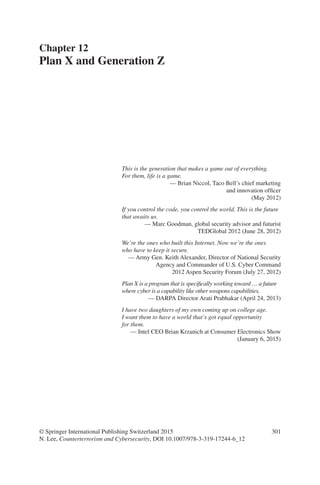
![302 12 Plan X and Generation Z
12.1 Plan X: Foundational Cyberwarfare
“Other countries are preparing for a cyber war,” said Richard M. George, a former
National Security Agency (NSA) cybersecurity official. “If we’re not pushing the
envelope in cyber, somebody else will” [1].
Since 2009, the Defense Advanced Research Projects Agency (DARPA) within
the U.S. Department of Defense (DoD) has been steadily increasing its cyber
research budget to $208 million in fiscal year 2012 [2].
In May 2012, DARPA officially announced Plan X [3]. The Plan X program is
explicitly not funding research and development efforts in vulnerability analysis or
the generation of cyber weapons. Instead, Plan X will attempt to create revolution-
ary technologies for understanding, planning, and managing military cyber opera-
tions in real-time, large-scale, and dynamic network environments. In November
2012, DARPA issued a call for proposals (DARPA-BAA-13-02) on Foundational
Cyberwarfare (Plan X) [4]:
Plan X will conduct novel research into the nature of cyber warfare and support devel-
opment of fundamental strategies needed to dominate the cyber battlespace. Proposed
research should investigate innovative approaches that enable revolutionary advances in
science, devices, or systems. Specifically excluded is research that primarily results in
evolutionary improvements to the existing state of practice.
The Plan X program seeks to build an end-to-end system that enables the military to
understand, plan, and manage cyber warfare in real-time, large-scale, and dynamic net-
work environments. Specifically, the Plan X program seeks to integrate the cyber battles-
pace concepts of the network map, operational unit, and capability set in the planning,
execution, and measurement phases of military cyber operations. To achieve this goal, the
Plan X system will be developed as an open platform architecture for integration with
government and industry technologies.
In April 2013, DARPA Director Arati Prabhakar held a press conference during
which she further clarified Plan X [5]:
Plan X is a program that is specifically working toward building really the technology
infrastructure that would allow cyber offense to move from the world we’re in today,
where it’s a fine, handcrafted capability that requires exquisite authorities to do anything
with it, that when you launch it into the world, you hope that it’s going to do what you
think it’s gonna do, but you don’t really know.
We need to move from there to a future where cyber is a capability like other weapons
capabilities, meaning that a military operator can design and deploy a cyber effect, know
what it’s going to accomplish, do battle damage assessment and measure what it has
accomplished, and, with that, build in the graduated authorities that allow an appropriate
individual to take an appropriate level of action.
Cybersecurity specialist Dan Roelker who conceived the Plan X idea explained,
“Say you’re playing World of Warcraft, and you’ve got this type of sword, +5 or
whatever. You don’t necessarily know what spells were used to create that sword,
right? You just know it has these attributes and it helps you in this way. It’s the
same type of concept. You don’t need the technical details” [6].
Figures 12.1a–f display Roelker’s rationale behind scalable cyber warfare and
the five pillars of “foundational cyberwarfare” [7].](https://image.slidesharecdn.com/4e941a39-7c10-40b2-bfdf-f00669949e38-150422133920-conversion-gate01/85/Counterterrorism-and-Cybersecurity-Total-Information-Awareness-31-320.jpg)
![323
To err is human. AI software modeled after humans will
inevitably make mistakes. It is fine as long as the software
learns from its errors and improves itself, which is something
that humans ought to learn from AI.
— Newton Lee
That men do not learn very much from the lessons of history is
the most important of all the lessons that history has to teach.
— Aldous Huxley in Collected Essays (1959)
A lot of cutting edge AI has filtered into general applications,
often without being called AI because once something becomes
useful enough and common enough it’s not labeled AI anymore.
— Nick Bostrom
Oxford University Future of Humanity Institute (2006)
Whenever an AI research project made a useful new discovery,
that product usually quickly spun off to form a new scientific or
commercial specialty with its own distinctive name.
— Professor Marvin Minsky
MIT Artificial Intelligence Laboratory (2009)
HAL’s not the focus; the focus is on the computer on ‘Star Trek’.
— David Ferrucci
IBM Thomas J. Watson Research Center (2011)
13.1 Artificial Intelligence: From Hollywood
to the Real World
In 1955, American computer scientist and cognitive scientist John McCarthy coined
the term “artificial intelligence” (AI). He defined AI as “the science and engineer-
ing of making intelligent machines, especially intelligent computer programs” [1].
Chapter 13
Artificial Intelligence and Data Mining
© Springer International Publishing Switzerland 2015
N. Lee, Counterterrorism and Cybersecurity, DOI 10.1007/978-3-319-17244-6_13](https://image.slidesharecdn.com/4e941a39-7c10-40b2-bfdf-f00669949e38-150422133920-conversion-gate01/85/Counterterrorism-and-Cybersecurity-Total-Information-Awareness-32-320.jpg)
![324 13 Artificial Intelligence and Data Mining
In the 2001 film A.I.: Artificial Intelligence, Steven Spielberg tells the story of a
highly advanced robotic boy who longs to become real so that he can regain
the love his human mother [2]. In 2004, Will Smith starred in the lead role of
I, Robot — a film based loosely on Isaac Asimov’s short-story collection of the
same name [3]. Although the Hollywood movies are quite far-fetched, AI hit the
spotlight on primetime television over three nights in February 2011 when the IBM
Watson computer won on “Jeopardy!” against two human champions and took
home a $1 million prize [4].
Watson, named after IBM founder Thomas J. Watson, has the ability of
encyclopedic recall and natural language understanding. “People ask me if
this is HAL,” said David Ferrucci, lead developer of Watson, referring to the
Heuristically programmed ALgorithmic (HAL) computer in 2001: A Space
Odyssey by Stanley Kubrick and Arthur C. Clarke. “HAL’s not the focus; the focus
is on the computer on ‘Star Trek,’ where you have this intelligent information
seeking dialogue, where you can ask follow-up questions and the computer can
look at all the evidence and tries to ask follow-up questions. That’s very cool” [5].
Watson was inspired by the Deep Blue project at IBM. Back in May 1997,
the IBM Deep Blue computer beat the world chess champion Garry Kasparov
after a six-game match, marking the first time in history that a computer had
ever defeated a world champion in a match play [6]. Since then, computers
have become much faster and software more sophisticated. In October 2012, the
U.S. Department of Energy unveiled the Titan supercomputer capable of 20 peta-
flops — 20 thousand trillion (20,000,000,000,000,000) floating point operations
per second [7].
Although our desktop computers are no match for the Titan, AI software has
entered mainstream consumer products. Apple’s intelligent personal assistant Siri
on iPhone, iPad, and iPod is the epitome of AI in everyday life. Siri uses voice
recognition and information from the user’s contacts, music library, calendars,
and reminders to better understand what the user says [8]. The software applica-
tion is an offshoot of SRI International’s CALO (Cognitive Assistant that Learns
and Organizes) project funded by the Defense Advanced Research Projects
Agency (DARPA) under its Perceptive Assistant that Learns (PAL) program
[9, 10]. Apple acquired Siri in April 2010, integrated it into iOS, and the rest is
history [11].
In addition to smartphones, domain-specific AI software applications have been
embedded into newer automobiles, interactive toys, home appliances, medical
equipment, and many electronic devices.
We do not often hear about AI in the real world, because as MIT Professor
Marvin Minsky explained, “AI research has made enormous progress in only a few
decades, and because of that rapidity, the field has acquired a somewhat shady rep-
utation! This paradox resulted from the fact that whenever an AI research project
made a useful new discovery, that product usually quickly spun off to form a new
scientific or commercial specialty with its own distinctive name” [12].](https://image.slidesharecdn.com/4e941a39-7c10-40b2-bfdf-f00669949e38-150422133920-conversion-gate01/85/Counterterrorism-and-Cybersecurity-Total-Information-Awareness-33-320.jpg)

![344 D. Manners
14.2 Short and Long Engagements
There are often two types of players. Those that tend to get to the end of a game
as quick as possible and those that methodically go along collecting everything as
they go. Penetration testers can do both depending upon the type and length of the
engagement.
In a short engagement the tester may try to show how quickly a potential threat
actor can achieve their objective. An example of a threat actor is organized crime.
Another would be state sponsored. There are many threat actors out there with var-
ying skillsets and resources. Time constraints may only allow a penetration tester
to find one attack vector. The objective is often privilege escalation (going from
no privilege to perhaps administrative privilege), obtain sensitive information or
something else.
A longer engagement often allows the penetration tester to be more methodi-
cal. The tester may be able to find multiple routes for the same objective. The
tester may also be able to become more in depth and create more complex
approaches. At times the test may be compared to a line of dominos. The suc-
cess of the test may be result of a number of factors set up by the tester. Like
dominos, the final domino will only fall as a result of the falling of all the other
dominos.
Often a penetration tester will use good judgment on the depth of the
penetration as compared to the fix to prevent future penetrations. An example
of this would a finding of a default credential. If the penetration test was a short
engagement is it worth spending an enormous amount of time exploiting every-
thing that was a result of a default credential when the fix is very simple? The
answer may be yes, if the results can justify the means, but often it may be a
simple highlight in a report and the tester will move on to find other attack vec-
tors. So like any game, how you play it may depend upon how much time you
have to hand.
14.3 A Game Already?
Penetration testing is already a game in all but name. It has:
1. An Objective and Rules
It has an objective that all parties agree on. During the initial phase, all parties
will agree to abide by a set of rules that creates the playing field. This client
being tested would be wise to allow an as open a playing field as possible so as
not to tip the odds in their favor, thus tainting the test. Sometimes this phase of
the test is the most important.
A good methodology such as the PTES (Penetration Testing Execution Standard)
can help create a balanced test as well as a good repeatable methodology —
important for testing [1].](https://image.slidesharecdn.com/4e941a39-7c10-40b2-bfdf-f00669949e38-150422133920-conversion-gate01/85/Counterterrorism-and-Cybersecurity-Total-Information-Awareness-35-320.jpg)
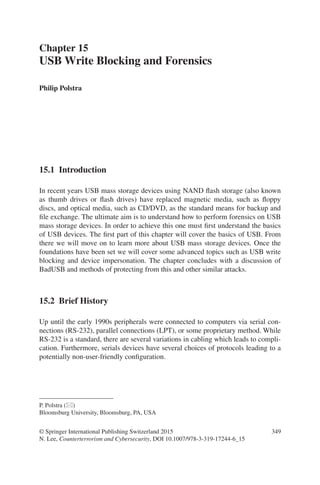

![429
The networked civilization we are building is going to need to
be able to make strong promises about the safety of software,
because it won’t just be guarding our data security — it will be
guarding our physical security.
— Mike Walker, DARPA Project Manager (June 3, 2014)
16.1 Cyber Grand Challenge Kick-off
On June 3, 2014, DARPA (Defense Advanced Research Projects Agency) kicked
off the first-ever Cyber Grand Challenge. DARPA project manager Mike Walker
and Naval Postgraduate School (NPS) lecturer Chris Eagle announced on reddit [1]:
We’re excited to share that our Cyber Grand Challenge kicks off today. The Cyber Grand
Challenge is simple: we’ve challenged the world to build high-performance computers1
that can play Capture the Flag (CTF), a computer security competition format pioneered
and refined by the hacker community over the past two decades. CGC is much more than
a tournament with up to $9 million in prizes (including a $2 million top prize).
As part of today’s launch event we’re releasing a brand new reference platform for CTF:
an Open Source platform purpose-built for security research and competition. It is, in
effect, a parallel digital universe in which this two-year-long competition will play out.
We’ve even included a few sample challenges to get the fun started.
Our competition framework team is assembled here at DARPA, so we’ll be here through-
out the day to answer questions here. We’re looking forward so AUA!
1The computer hardware in CTF must fit entirely in a single, standard 19″ 42U rack [24].
Chapter 16
DARPA’s Cyber Grand Challenge
(2014–2016)
© Springer International Publishing Switzerland 2015
N. Lee, Counterterrorism and Cybersecurity, DOI 10.1007/978-3-319-17244-6_16](https://image.slidesharecdn.com/4e941a39-7c10-40b2-bfdf-f00669949e38-150422133920-conversion-gate01/85/Counterterrorism-and-Cybersecurity-Total-Information-Awareness-38-320.jpg)
![430 16 DARPA’s Cyber Grand Challenge (2014–2016)
edit: proof! http://i.imgur.com/wL1bnL9.jpg2
Thanks everyone! -Mike, Chris, and Team CGC
The CGC launch on reddit AMA (Ask Me Anything) or AUA (Ask Us Anything)
attracted about 128 comments. The following were some of the most popular
QA’s on reddit:
Q [rataza]: The current state of the art (i.e. KLEE3 and S2E4) is capable of auto-
matically discovering some bugs in command line tools and straight forward net-
work daemons. Will you provide challenges that they or similar tools can solve? Or
will the challenges resemble complex network daemons, like SMTP servers or
OpenSSH? It seems that would require a generational leap in automated tools.
A [Chris Eagle]: Our goal is simple: start with the current state of the art and
push it as far as we can. As such, we expect our challenges to range in difficulty
from solvable today to potentially unsolvable even at the conclusion of CGC.
Ideally by the time we are done the technology that has been developed will be
able to solve a much larger percentage of our challenges than can be solved today.
For program analysis, we’ve simplified the problems of isolating entropy, input
and output from the operating system down to a bare minimum. We have just
seven system calls with no polymorphism or ambiguity in the ABI. Our simple
binary format has a single entry point method and no dynamic loader. DECREE’s
“OS tax”, the bane of automation research, is as close to zero as any platform in
existence.5
Q [gynophage]: You seem to have a lot invested in the attack/defense model of
computer security competition. I’ve heard arguments from many players that the
current model of attack/defense CTF is “stale”. Do you believe these events are
stale? If so, do you think there will be any innovations from the Cyber Grand
Challenge that the CTF community will be able to use to continue generating
2Figure 16.1 is the Cyber Grand Challenge infrastructure team at the DARPA office building on
June 3, 2014. Chris Eagle wrote on reddit: “The photo is our AMA ‘proof’. Many of us brought
totems from our former work. The sheep is the mascot of DDTEK, past organizers of DEFCON
CTF. The books on her lap are the Federal Acquisition Regulations (FAR) and Defense Federal
Acquisitions Supplement (DFARS) (which may be relevant to one of the challenge binaries). The
other paper is the front page of the science section of today’s New York Times.”
3KLEE is a symbolic virtual machine built on top of the LLVM compiler infrastructure, which
uses a theorem prover to try to evaluate all dynamic paths through a program in an effort to find
bugs and to prove properties of functions. A major feature of KLEE is that it can produce a test
case in the event that it detects a bug [26].
4S2E is a platform for analyzing the properties and behavior of software systems. S2E has been
used to develop practical tools for comprehensive performance profiling, reverse engineering of
proprietary software, and bug finding for both kernel-mode and user-mode binaries [27].
5DECREE = DARPA Experimental Cyber Research Evaluation Environment. DECREE is an
open-source extension built atop the Linux operating system. Constructed from the ground up
as a platform for operating small, isolated software test samples that are incompatible with any
other software in the world—DECREE aims to provide a safe research and experimentation envi-
ronment for the Cyber Grand Challenge [24].](https://image.slidesharecdn.com/4e941a39-7c10-40b2-bfdf-f00669949e38-150422133920-conversion-gate01/85/Counterterrorism-and-Cybersecurity-Total-Information-Awareness-39-320.jpg)

